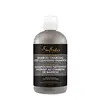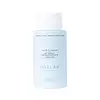What's inside
What's inside
 Key Ingredients
Key Ingredients

 Benefits
Benefits

 Concerns
Concerns

 Ingredients Side-by-side
Ingredients Side-by-side

Water
Skin ConditioningSodium Lauroyl Methyl Isethionate
CleansingCocamidopropyl Betaine
CleansingGlycol Distearate
EmollientParfum
MaskingPanthenol
Skin ConditioningGuar Hydroxypropyltrimonium Chloride
Skin ConditioningAloe Barbadensis Leaf Juice
Skin ConditioningSodium Benzoate
MaskingTocopheryl Acetate
AntioxidantMelaleuca Alternifolia Leaf Oil
AntioxidantSalix Nigra Bark Extract
Skin ProtectingButyrospermum Parkii Butter
Skin ConditioningArgania Spinosa Kernel Oil
EmollientSimmondsia Chinensis Seed Oil
EmollientCharcoal Powder
AbrasiveMacadamia Ternifolia Seed Oil
EmollientCocos Nucifera Oil
MaskingElaeis Guineensis Kernel Oil
EmollientTheobroma Cacao Husk
AbrasiveGlycerin
HumectantTrisodium Ethylenediamine Disuccinate
Triethyl Citrate
MaskingCaprylyl Glycol
EmollientBenzoic Acid
MaskingWater, Sodium Lauroyl Methyl Isethionate, Cocamidopropyl Betaine, Glycol Distearate, Parfum, Panthenol, Guar Hydroxypropyltrimonium Chloride, Aloe Barbadensis Leaf Juice, Sodium Benzoate, Tocopheryl Acetate, Melaleuca Alternifolia Leaf Oil, Salix Nigra Bark Extract, Butyrospermum Parkii Butter, Argania Spinosa Kernel Oil, Simmondsia Chinensis Seed Oil, Charcoal Powder, Macadamia Ternifolia Seed Oil, Cocos Nucifera Oil, Elaeis Guineensis Kernel Oil, Theobroma Cacao Husk, Glycerin, Trisodium Ethylenediamine Disuccinate, Triethyl Citrate, Caprylyl Glycol, Benzoic Acid
Aloe Barbadensis Leaf Juice
Skin ConditioningSodium Methyl Cocoyl Taurate
CleansingSodium Lauroyl Methyl Isethionate
CleansingCocamidopropyl Betaine
CleansingCocamide Mipa
EmulsifyingGlycerin
HumectantSodium Hyaluronate
HumectantHydrolyzed Hyaluronic Acid
HumectantNiacinamide
SmoothingAvena Sativa Kernel Extract
AbrasiveAlthaea Officinalis Root Extract
Skin ConditioningHelianthus Annuus Flower
Skin ConditioningSalvia Officinalis Oil
MaskingPanthenol
Skin ConditioningTocopheryl Acetate
AntioxidantGuar Hydroxypropyltrimonium Chloride
Skin ConditioningSodium Lauroyl Glutamate
PEG-150 Distearate
EmulsifyingGlycol Distearate
EmollientMagnesium Chloride
Citric Acid
BufferingPhenoxyethanol
PreservativeChlorphenesin
AntimicrobialSodium Benzoate
MaskingAloe Barbadensis Leaf Juice, Sodium Methyl Cocoyl Taurate, Sodium Lauroyl Methyl Isethionate, Cocamidopropyl Betaine, Cocamide Mipa, Glycerin, Sodium Hyaluronate, Hydrolyzed Hyaluronic Acid, Niacinamide, Avena Sativa Kernel Extract, Althaea Officinalis Root Extract, Helianthus Annuus Flower, Salvia Officinalis Oil, Panthenol, Tocopheryl Acetate, Guar Hydroxypropyltrimonium Chloride, Sodium Lauroyl Glutamate, PEG-150 Distearate, Glycol Distearate, Magnesium Chloride, Citric Acid, Phenoxyethanol, Chlorphenesin, Sodium Benzoate
Ingredients Explained
These ingredients are found in both products.
Ingredients higher up in an ingredient list are typically present in a larger amount.
Aloe Barbadensis Leaf Juice comes from leaves of the aloe plant. Aloe Barbadensis Leaf Juice is best known for helping to soothe sunburns. It is also anti-inflammatory, moisturizing, antiseptic, and can help heal wounds.
Aloe is packed with good stuff including Vitamins A, C, and E. These vitamins are antioxidants, which help fight free-radicals and the damage they may cause. Free-radicals are molecules that may damage your skin cells, such as pollution.
Aloe Barbadensis Leaf Juice also contains sugars. These sugars come in the form of monosaccharides and polysaccharides, folic acid, and choline. These sugars are able to help bind moisture to skin.
It also contains minerals such as calcium, 12 anthraquinones, fatty acids, amino acids, and Vitamin B12.
Learn more about Aloe Barbadensis Leaf JuiceCocamidopropyl Betaine is a fatty acid created by mixing similar compounds in coconut oil and dimethylaminopropylamine, a compound with two amino groups.
This ingredient is a surfactant and cleanser. It helps gather the dirt, pollutants, and other impurities in your skin to be washed away. It also helps thicken a product and make the texture more creamy.
Being created from coconut oil means Cocamidopropyl Betaine is hydrating for the skin.
While Cocamidopropyl Betaine was believed to be an allergen, a study from 2012 disproved this. It found two compounds in unpure Cocamidopropyl Betaine to be the irritants: aminoamide and 3-dimethylaminopropylamine. High-grade and pure Cocamidopropyl Betaine did not induce allergic reactions during this study.
Learn more about Cocamidopropyl BetaineGlycerin is already naturally found in your skin. It helps moisturize and protect your skin.
A study from 2016 found glycerin to be more effective as a humectant than AHAs and hyaluronic acid.
As a humectant, it helps the skin stay hydrated by pulling moisture to your skin. The low molecular weight of glycerin allows it to pull moisture into the deeper layers of your skin.
Hydrated skin improves your skin barrier; Your skin barrier helps protect against irritants and bacteria.
Glycerin has also been found to have antimicrobial and antiviral properties. Due to these properties, glycerin is often used in wound and burn treatments.
In cosmetics, glycerin is usually derived from plants such as soybean or palm. However, it can also be sourced from animals, such as tallow or animal fat.
This ingredient is organic, colorless, odorless, and non-toxic.
Glycerin is the name for this ingredient in American English. British English uses Glycerol/Glycerine.
Learn more about GlycerinGlycol Distearate serves as a pearlizing or opacifying agent in cosmetic products.
It's often included in cleansers and haircare products to give them a lustrous or shimmering appearance.
It is derived from stearic acid, a natural fatty acid commonly found in vegetable oils and animal fats.
Glycol Distearate isn't fungal acne safe.
Learn more about Glycol DistearateThis ingredient is derived from guar gum.
It is a conditioning ingredient, meaning it helps soften skin and hair.
Panthenol is a common ingredient that helps hydrate and soothe the skin. It is found naturally in our skin and hair.
There are two forms of panthenol: D and L.
D-panthenol is also known as dexpanthenol. Most cosmetics use dexpanthenol or a mixture of D and L-panthenol.
Panthenol is famous due to its ability to go deeper into the skin's layers. Using this ingredient has numerous pros (and no cons):
Like hyaluronic acid, panthenol is a humectant. Humectants are able to bind and hold large amounts of water to keep skin hydrated.
This ingredient works well for wound healing. It works by increasing tissue in the wound and helps close open wounds.
Once oxidized, panthenol converts to pantothenic acid. Panthothenic acid is found in all living cells.
This ingredient is also referred to as pro-vitamin B5.
Learn more about PanthenolSodium Benzoate is a preservative. It's used in both cosmetic and food products to inhibit the growth of mold and bacteria. It is typically produced synthetically.
Both the US FDA and EU Health Committee have approved the use of sodium benzoate. In the US, levels of 0.1% (of the total product) are allowed.
Sodium benzoate works as a preservative by inhibiting the growth of bacteria inside of cells. It prevents the cell from fermenting a type of sugar using an enzyme called phosphofructokinase.
It is the salt of benzoic acid. Foods containing sodium benzoate include soda, salad dressings, condiments, fruit juices, wines, and snack foods.
Studies for using ascorbic acid and sodium benzoate in cosmetics are lacking, especially in skincare routines with multiple steps.
We always recommend speaking with a professional, such as a dermatologist, if you have any concerns.
Learn more about Sodium BenzoateSodium Lauroyl Methyl Isethionate is a cleansing ingredient. It is a surfactant, meaning it helps gather dirt, oil, and other pollutants. This helps them be rinsed away easily.
Tocopheryl Acetate is AKA Vitamin E. It is an antioxidant and protects your skin from free radicals. Free radicals damage the skin by breaking down collagen.
One study found using Tocopheryl Acetate with Vitamin C decreased the number of sunburned cells.
Tocopheryl Acetate is commonly found in both skincare and dietary supplements.
Learn more about Tocopheryl Acetate